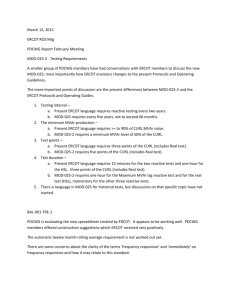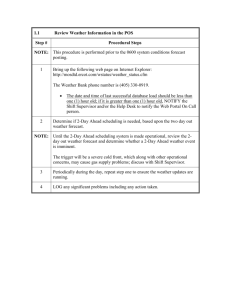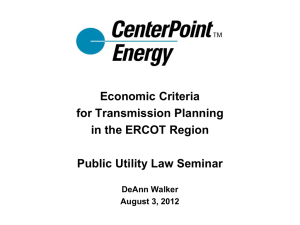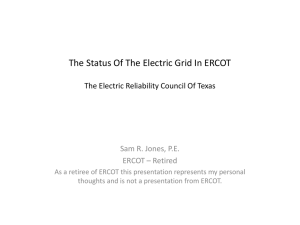OWG UFLS Survey and Power Factor review
advertisement
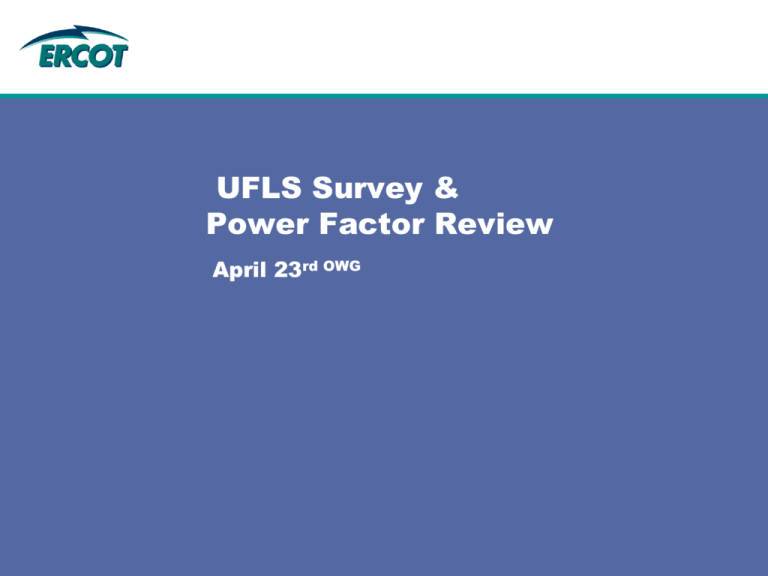
UFLS Survey & Power Factor Review April 23rd OWG 2014 UFLS Survey – Summary of Changes Previous Surveys 2014 Survey PRC -007 Op Guides 2.6.1 (2) TRE ERCOT & TSPs Reported by pss/e Bus number Mid April Submit 30 days after survey date Threshold summary Bus Detail Not Required 5/13 11:00 (OBO – time) Submit No Later Than 6/13/14 Update TAC when compliance is achieved. 2 PRC 006-01 & PRC-007-0 NERC PRC Standards 6&7 PRC-007-0 Effective 4/1/05, Inactive 9/30/13 Replaced with PRC-006-1 PRC-006-1 Enforceable 10/1/13 PRC-006-0 NERC approved FERC did not remand or approve Version 0 ERCOT Planning Functions & Dynamics WG Processes ERCOT 5 year Review of UFLS Program Data Collection & Retention Planning Guide §6.2.3 Dynamics Data Requirements for T/DSP Dynamics Working Group Procedures 3.4.1 UFLS Relay Data collection 4.2.2 Stability Book 3 Operating Guides Section 2.6 UFLS Requirements 2.6.1(1) at least 25%... 2.6.1(2) With the assistance of applicable Transmission Service Providers (TSPs), ERCOT will, prior to the peak each year, survey each Distribution Service Provider’s (DSP’s) compliance with the automatic Load shedding steps above, and report its findings to the Technical Advisory Committee (TAC). For minimum compliance, DSPs are obligated to meet the prescribed percent values at all times. It is not permitted to use rounding to meet the minimum. ERCOT will direct a review of the automatic firm Load shedding program whenever warranted by conditions. At a minimum, this review will follow the Reliability and Operations Subcommittee (ROS) directed dynamic simulations of automatic firm Load shedding conducted at five-year intervals beginning in the Summer of 2001. 4 UFLS Program 2015 Additional Information Incorporate tenets in other sections of 2.6.1 Location / Zone Rolling / Re -arming Responsibility Transfers (Limited to Compliance) Limited Attestation Only Less Remove Survey Monitor Performance 5 Power Factor Load Flow Studies Annual Load Data Request Distribution Power Factors Submitted to ERCOT Via ALDR Expressed on high side Drawing VARs is positive, providing VARs negative Incorporated in SSWG /Planning Base Cases Confirmation Every study preformed on the ERCOT System Assumes Appropriateness & Accuracy in Load Forecasting Operations Horizon – less likely ICCP data Estimated Existing ICCP Default PF (CIM, ALDR) ? Confirmation 6 Power Factor Requirements –ERCOT §3.15.1 ERCOT Responsibilities Related to Voltage Support (4) For any Market Participant’s failure to meet the Reactive Power voltage control requirements of these Protocols, ERCOT shall notify the Market Participant in writing of such failure and, upon a request from the Market Participant, explain whether and why the failure must be corrected. (6) Annually, ERCOT shall review Distribution Service Provider (DSP) power factors using the actual summer Load and power factor information included in the annual Load data request to assess whether DSPs comply with the requirements of this subsection. At times selected by ERCOT, ERCOT shall require manual power factor measurement at substations and POIs that do not have power factor metering. ERCOT shall try to provide DSPs sufficient notice to perform the manual measurements. ERCOT may not request more than four measurements per calendar year for each DSP substation or POI where power factor measurements are not available. (7) If actual conditions indicate probable non-compliance of TSPs and DSPs with the requirements to provide voltage support, ERCOT shall require power factor measurements at the time of its choice while providing sufficient notice to perform the measurements. (8) ERCOT shall investigate claims of TSP and DSP alleged non-compliance with Voltage Support requirements. The ERCOT investigator shall advise ERCOT and TSP planning and operating staffs of the results of such investigations. 7 Power Factor Requirements –DSP & PUN §3.15.2 Or at their option, may meet alternative requirements specifically approved by ERCOT a) PF > .97(lagging) for Max Net Active (MW) Low side of .97 Unless Tariff says it is not a requirement b) Load >10 MW require Watt/VAR metering Za ≠ Zb c) d) ALDR High Side Confirmation ALDR See a) & c) 8 NERC Power Factor Requirements Version 0 Standards found lacking The Commission believes that Reliability Standard VAR-001-1 is an appropriate place for the ERO to take steps to address these concerns by setting out requirements for transmission owners and LSEs to maintain an appropriate power factor range at their interface. We direct the ERO to develop appropriate modifications to this Reliability Standard to address the power factor range at the interface between LSEs and the BulkPower System. VAR-001-3 (R5) Addressed the Directive: R5. Each Purchasing-Selling Entity and Load Serving Entity shall arrange for (selfprovide or purchase) reactive resources – which may include, but is not limited to, reactive generation scheduling; transmission line and reactive resource switching;, and controllable load– to satisfy its reactive requirements identified by its Transmission Service Provider. 9 NERC VAR -001-3 Current Language R5. Each Purchasing-Selling Entity and Load Serving Entity shall arrange for (self-provide or purchase) reactive resources – which may include, but is not limited to, reactive generation scheduling; transmission line and reactive resource switching;, and controllable load– to satisfy its reactive requirements identified by its Transmission Service Provider. (Retirement approved by FERC effective January 21, 2014.) VAR-001-4 Standard is not approved and It will not address the power factor when finalized NERC indicates this standard wa retired as part of the Paragraph 81 Project The Redundancy (FERC, below) may also reference OATT PER FERC: ‘Retired …………, and VAR-001-2, Requirement R5 because those requirements were found redundant with other requirements’ – Federal Register V78. #235 (12/6/13) 10 Low Power Factors in Load Flow and Load Flow approximations As Power Factors become more Lagging, Circulating Currents Increase Power Consumed by load Increases System Efficiency Decreases Lines with higher current carrying capacity are Required More Generation is Required Available Transfer Capacity Decreases Loads with Significantly lagging Power Factors attribute Reduced Available Transfer Capability into load pockets and other constrained flowgates, and may lead to Voltage Instability and Voltage Collapse. This is a problem under peak conditions 11

